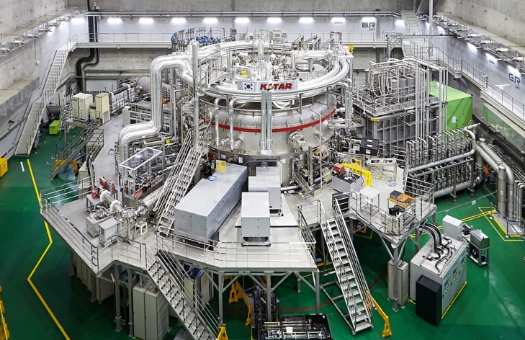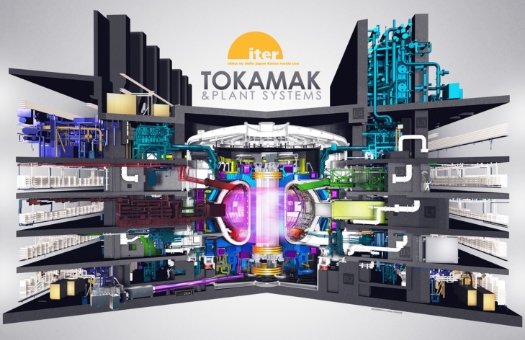Research
Research
Both KSTAR and ITER are essential routes for DEMO and commercial road development- KSTAR is the cradle of fusion technology independence.
-
Before ITER operation, advanced levels of plasma experiment, control, and analysis capabilities are to be secured. KSTAR is the cradle of R&D, human resource development, and education of underlying technologies for fusion.
- Participating in ITER does not guarantee the establishment of fusion technology.
-
ITER's prime goal is to demonstrate fusion energy from the engineering point of view, provided that fundamental technologies such as plasma physics are secured.
To realize such basic technologies, KSTAR is more than essential.- With the technologies attained by both KSTAR and ITER, the construction and operation of the DEMO will be carried out, and the construction of a Korean fusion power plant in the 2040s becomes feasible.
Comparison between the KSTAR and the ITER

KSTAR Device

ITER Device Model
Key technologies we can obtain through KSTAR operation and ITER participation
KSTAR operation
-
Original technology for manufacturing a superconducting fusion device
- Superconducting magnets
- Vacuum vessels and plasma diagnostic devices
- Large-capacity power supplies, etc.
-
Original technology for operating a superconducting fusion device
- Plasma heating and diagnostic technology
- High-density plasma generation and control technology
- Basic research to develop plasma core materials
ITER participation
-
Base technology for designing a fusion reactor
- Plasma core analysis and control
- Design of blanket, tritium fuel system, etc.
- Design of extra-large vacuum vessels, etc.
- Establishment of industry standards and specifications, etc.
-
Original technology for operating a superconducting fusion device
- Manufacturing and assembly technology of main components
- Construction and operation licenses, etc.
Roadmap for Korean fusion energy development
-
Stage 1 Basic research (Government investment)
2010s
KSTAR- High-performance, high-efficiency long-term operation research
- Research on fusion control technology
- Optimization of fusion reactions
- Optimization of ITER driving skills
- Serve as a pilot plant for the ITER
-
Stage 2 Basic research & new energy development(Government investment)
2020s
ITER- Research on fusion fuel and material
- Research on heat utilization
- Research on device engineering
- Research on D-T fusion reactions
- Research on blanket technology research
-
Stage 3 New energy development (Government & private investment)
2030s
DEMO- Practical technology development
- System optimization
- Realization of economically viable fusion reactors
-
Stage 4 Commercialization of the new energy (Private investment)
2040s
Commercialization- Construction and operation of commercial power plants
- Large-capacity electricity production and transmission
- Development of Korean nuclear fusion power plants
- Engineering design completion

보안문자를 입력 후 확인 버튼을 누르세요.
